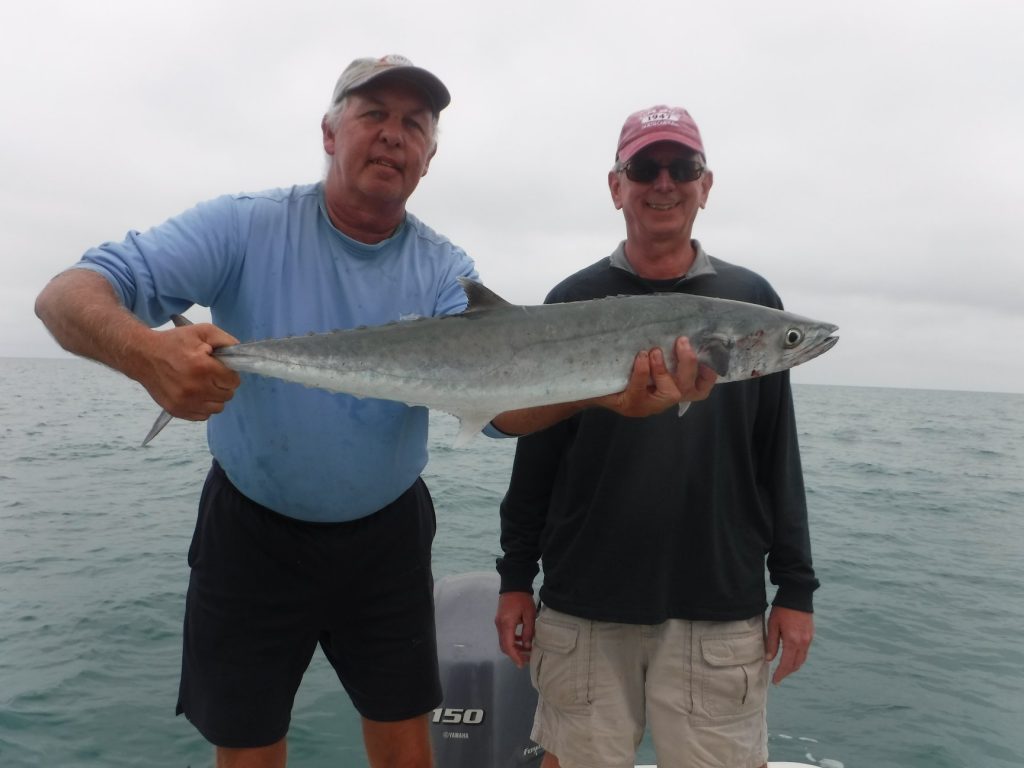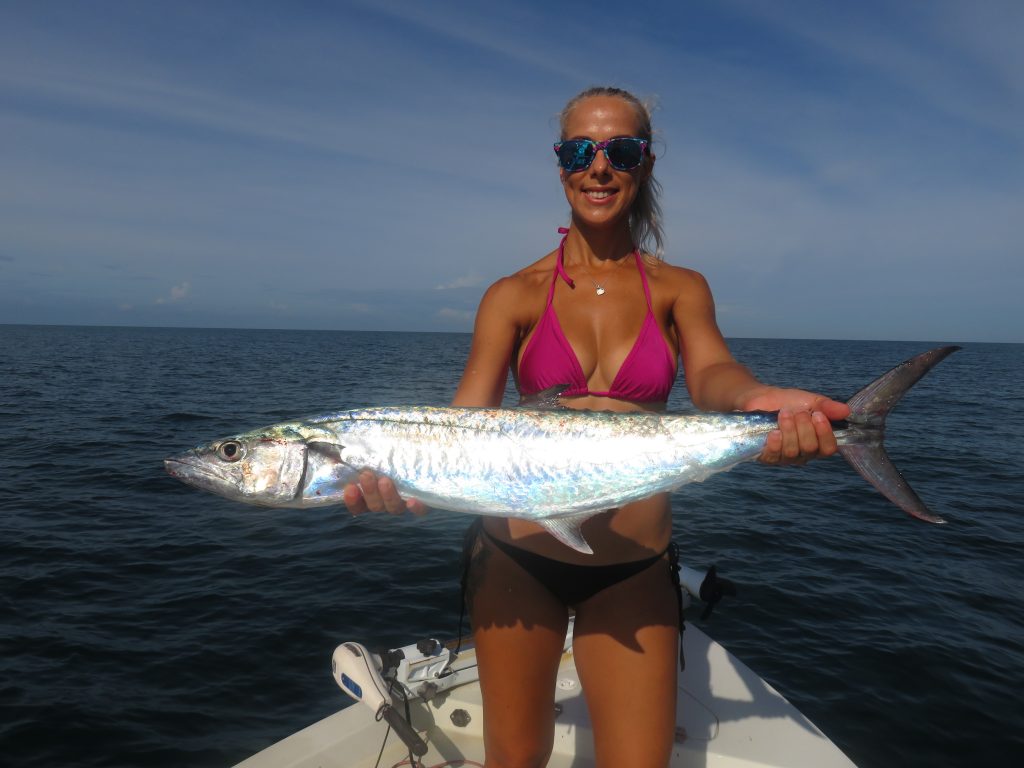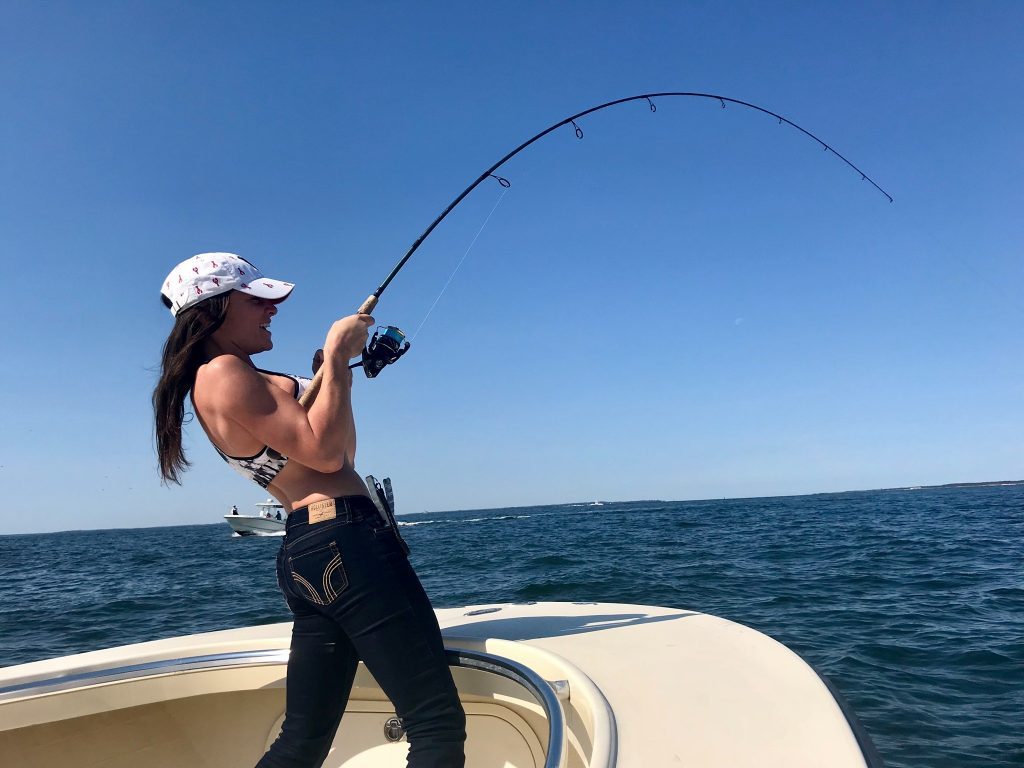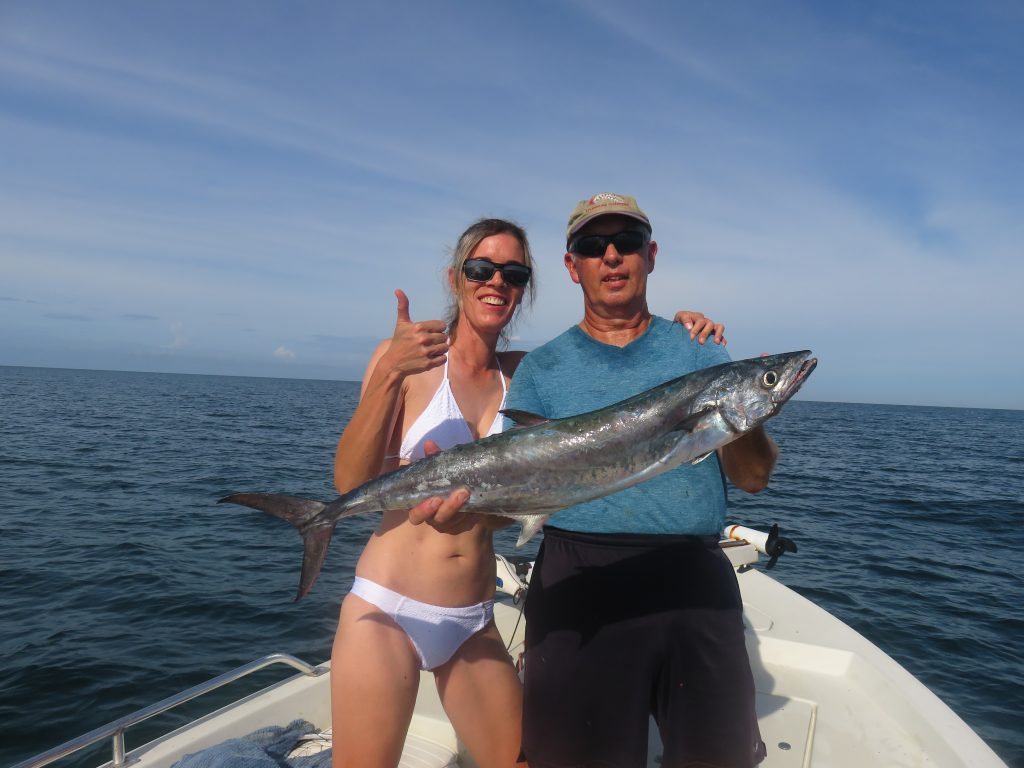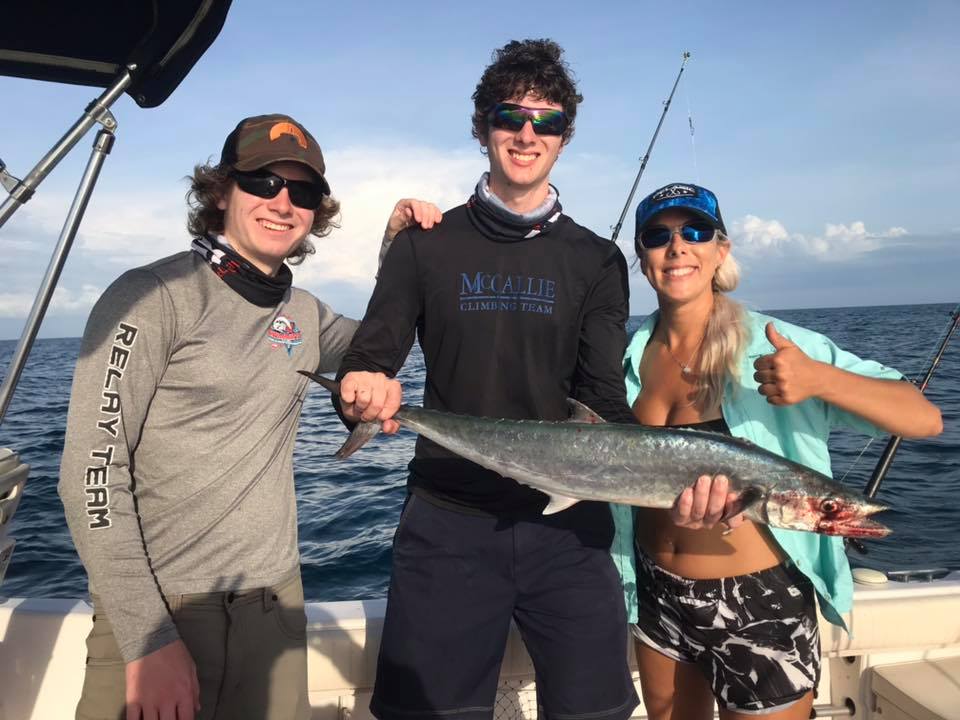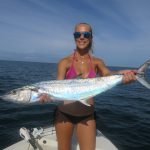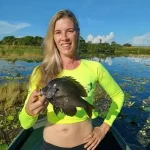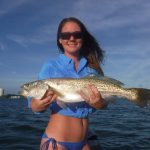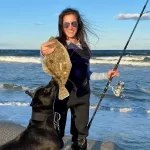How to Catch King Mackerel – Pro Tips!
This article will thoroughly cover how to catch king mackerel. King mackerel, also known as kingfish, are a very popular pelagic saltwater species. This means that they spend the majority of their time in the upper part of the water column and are always on the move. Anglers disagree on the food value of king mackerel, though many enjoy them when prepared fresh or smoked.
I am a full-time fishing guide in Siesta Key, Florida and have been doing it for over 30 years. In my area of Siesta Key, king mackerel migrate through in the spring and then again in the fall. I worked as a mate on a larger boat and learned all the intricacies of trolling both hardware and live bait for king mackerel. I will share these tips and were in the following article.
King mackerel are found in warm and temperate waters all over the world. They are the second largest member of the mackerel family, only ranking behind wahoo and size. Their smaller cousins are the Spanish mackerel and cero mackerel. Schoolie king mackerel average 5 to 10 pounds, but they grow much larger. The world record king mackerel is a whopping 98 pounds!
How to catch king mackerel
For the most part, anglers chasing king mackerel find them between a few miles from shore and 15 miles out. This is often the range where the forage such as threadfin herring, cigar minnows, menhaden, and blue runners tend to be found. These are large schools of bait attract king mackerel and other species such as tarpon, cobia, sharks, jacks, and more.
Trolling is by far the most productive and widely used technique by anglers targeting king mackerel. This allows them to cover a lot of water while presenting multiple baits at different depths in the water column. Artificial lures are very productive, with spoons and plugs being the top choices. Slow trolling with live bait fish often produces the larger king mackerel and is a technique used by most tournament anglers.
Best king mackerel fishing tackle
The tackle used by anglers fishing for king mackerel is pretty basic. In fact, many experienced saltwater anglers already have outfits that will work fine. Both spinning tackle and conventional tackle have their place when fishing for king mackerel. Conventional gear is the best choice when trolling lures while spinning tackle works great for slow trolling live baits and for drifting live baits and chunks.
A 7 foot medium conventional rod with a fast action is an excellent all round choice when fishing for king mackerel. It will work very well for trolling both lures and live baits as well as drifting out live baits and chunks of cut bait. A fast rod is preferred. This means that the butt section is stiff while the rod is fairly limber. This is especially important when slow trolling live baits with a stinger rig, as the hooks can easily pull.
A similar sized spinning outfit would be the second rod and reel combination added to the king mackerel fishing arsenal. A 7 1/2 foot to 8 foot rod, again medium action with a fast taper, paired with an 8000 series reel works very well. It is important for the spinning reel to have a large capacity of line as well as a very smooth drag. Outfits used for tarpon and sailfish would generally work well in this application.
Anglers fishing for king mackerel have two basic choices when it comes to line; monofilament and braided line. Many anglers have switched over to braided line as it adds a significant amount of capacity. However, braided line does not stretch and this can result in hooks pulling, especially right at the boat. Monofilament line has a lot of stretch but is of thicker diameter. It really is just angler preference. I still use monofilament line for most of my king mackerel fishing.
Trolling for king mackerel
As mentioned earlier in this article, the vast majority of king mackerel caught by anglers are done so trolling. Trolling is just the act of driving the boat while pulling baits behind. It is simple, however not that simple and there are definitely techniques and tips that will improve the success of anglers chasing the speedy game fish. Trolling with lures and trolling with live bait to be covered separately.
I am going to insert a word of caution here for anglers new to fishing for king mackerel. These fish are large with a mouth full of razor sharp teeth. Care needs to be exercise when handling. Fish which are going to be kept can be gaffed. Release tools are invaluable in getting a king mackerel off the hook that is going to be released. Also, anglers are often dealing with sharp treble hooks. Again, care must be exercised as a thrashing angry king mackerel can easily embed a hook in the anglers hand.
Best king mackerel fishing lures
Trolling for king mackerel with lures is actually easier than using live bait. Lures will generally produce more action, though the fish tend to average smaller in size. Part of the reason for the increase in numbers is the fact that anglers trolling lures for king mackerel do so at a surprisingly high speed; around 6 knots or so. This allows anglers to cover a lot of water in search of fish.
My favorite lure for trolling for king mackerel by far is a large trolling spoon. There are several manufacturers including King spoons and Clark spoons along with many others that sell a quality trolling spoon. These trolling spoons are long and slender. The design allows for anglers to troll quite quickly with the spoon putting out a lot of flash and vibration. Anglers can choose from a variety of colors, with silver being an excellent choice in most conditions.
Some type of device must be used in order to get the spoon down in the water column. The two most popular methods are in line trolling sinkers and planers. Trolling sinkers are the easiest. The angler simply ties the trolling sinker to the running line that attaches the spoon to the sinker with 20 feet or so of 50 pound to 80 pound fluorocarbon leader. 4 to 6 ounce sinkers are usually required.
Trolling for king mackerel with planers
Planers are very clever devices yet a tad more complicated. The planer is tied to the running line and again a 20 foot leader connects the planer to the spoon. However, when trolling with a planer it must be set. This causes the planer to dig down into the water as the boat is moved along. When a fish strikes, the planer will trip and allow the angler to fight the fish unencumbered by the pull of the planer. Conventional tackle is preferred when trolling planers.
Planers come in several sizes. A number one planer will dive down 5 to 7 feet, a number two planer will dive down 12 to 15 feet, and a number three planer will dive down 30 feet or so. Most anglers use a number one or number two planer. Trolling a number three planer requires a very stout rod just to compensate for the pull of the planer.
The technique is similar when using both planers and it line sinkers. The lines are let out behind the boat to a determined distance and then the reel is engaged. Varying the distances will help alleviate tangles. Deeper lines are put out closer, shallower lines further back. The rods are put in holders and the boat is troll around at 5 to 7 kn. When a strike occurs, the boat is slow down in the fish is reeled in. Once the sinker or planer gets to a foot or so of the rod tip, the fish must be hand lined in the rest of the way. Multiple hookups are common.
Trolling for king mackerel with plugs
Trolling with plugs is much simpler. The lip on the plug along with the diameter of the line will determine how deep it runs. I like to double 6 feet of the running line using a spider hitch and then use a double Uni knot to attach 5 feet of 80 pound fluorocarbon leader. I then tie on the plug.
As when trolling with spoons, the plugs are simply let out behind the boat. Where possible, I like to troll one plug in conjunction with two spoons. Trolling a number one planer, a number two planer, in a shallow diving plug covers the upper parts of the water column and I have found this to be a consistent combination for catching king mackerel.
There are several manufacturers who offer quality plugs for anglers trolling for king mackerel. The hardware needs to be stout for catching these large game fish. I prefer the Rapala X-Rap line of baits. Bomber Long A saltwater plugs are very popular as well, with gold being the top color. The larger Yozuri Crystal Minnow plugs are popular ineffective as well, especially in the prism finish.
Trolling with live bait for king mackerel
Trolling with live bait may seem like it should be easier, but in ways it is more difficult and complicated. Perhaps the primary reason for this is that unlike lures which can be stored in a tackle box, live bait must be procured and kept alive. This is usually done in the morning of the fishing trip, though some serious anglers go out and catch bait ahead of time and keep it penned up.
As mentioned earlier, a wide variety of baits can be used when slow trolling for king mackerel. Top baits change by region, with blue runners, goggle eye, threadfin herring, cigar minnows, scaled sardines, mullet, and menhaden being the top choices. Even inshore bait fish such as pin fish can be used successfully.
In some instances live bait can be purchased. Anglers do not need a lot of baits, depending on the situation in the bait being used. Also, it is important not to crowd them in the bait well. Anglers catching their own bait usually opt for a Sabiki rig. This is a string of small flies or gold hooks that are used to attract the bait fish. Anglers can also use a cast net in some situations to procure their baits as well.
Most anglers trolling live bait for king mackerel use a Stinger rig. These can be made at home or purchased already assembled. I choose to go the latter route and purchase my leaders already assembled and ready to go. These rigs consist of a long wire leader followed by a pair of hooks. The front hook can be a J hook or a treble hook while the rear is usually a treble hook.
The front hook is used to secure the bait fish. Depending on the bait being used, the most common method is to hook the bait through the nose. It is best to avoid hooking it from inside the mouth as this will result in it dying more quickly. The rear or second hook is then inserted lightly into the upper back. The vast majority of king mackerel hooked will be caught on the rear hook also known as the stinger hook.
Anglers trolling live baits do so at a much slower speed than those using lures. Therefore, a lot less water can be covered. Most anglers employing this technique do so over a specific area such as an artificial reef or ledge where king mackerel tend to congregate over large bait schools. Trolling the edges of large bait schools or bait balls as effective as well.
In most situations, I like to slowly troll live bait for king mackerel using two baits at varying lengths behind the boat. I will count the first one back 10 seconds and the second one back 15 seconds. This allows for the boat to make turns without the lines tangle. The trolling speed is idle or just a tad above as any faster will cause the bait’s to look unnatural in the water. I do prefer spinning tackle when slow trolling live baits for king mackerel.
Anchoring and drifting for king mackerel
While trolling accounts for the vast majority of king mackerel caught by anglers, they are also landed by those drifting in anchoring as well. Many anglers enjoy the action and variety that comes from anchoring on a reef or rack and chumming fish up behind the boat. This certainly works for king mackerel as well as it does many other species. Anglers can drift a chunk of bait or free line a live bait on a Stinger rig out behind the boat.
Drifting can be used to catch king mackerel as well. This is often done on days where it is too deep or too rough to anchor. In most cases, a large live bait is preferred. It is hooked on a Stinger rigged just as would be done when trolling and then drifted out behind the boat.
Top king mackerel fishing spots
King mackerel can be found just about anywhere at times. However, there are certain locations that are more high percentage than others. Many areas have artificial reef systems, and these are havens for king mackerel as they attract schools of bait over the structure. Trolling works well but anglers can anchor and fish if they prefer.
Natural ledges will also attract king mackerel. This is particularly true in the Gulf of Mexico where structure is less plentiful. King mackerel will relate to the ledges just as they do other types of structure. Many anglers overlook ledges when targeting king mackerel, and this is a mistake!
Finally, catching king mackerel can be as simple as finding the bait. On-call days, large schools of bait fish can be seen dimpling on the surface. Sometimes Spanish mackerel, false albacore, and other species will be feeding on the bait. King mackerel will often be just below the surface activity. Slow trolling a live bait around the edges of these bait balls can be extremely effective.
As mentioned right in the beginning, opinions differ as to the quality of king mackerel fillets when it comes to eating. I personally love them! However, they must be put on ice immediately and eaten within a day or two of being caught. King mackerel are oily and the fillets will spoil quickly. They are fantastic when smoked. As with all fishing, it is important to be responsible in the harvest of these fish, especially given the fact that they do not freeze well at all. Keep a medium sized fish or two for the table and let the big girls go.
In conclusion, this article on how to catch king mackerel will help anglers be more successful when targeting these popular and hard fighting saltwater game fish!

